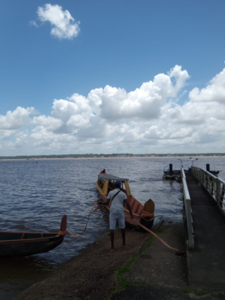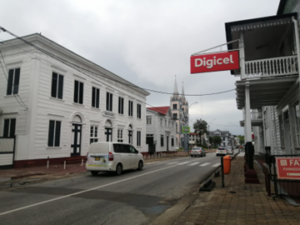By Karlijn Korpershoek
15 hours and 35 minutes.
That is how long it took the Axiom 2 mission to get to the International Space Station from their lift off point at Cape Canaveral, Florida. With that time, SpaceX set its own new record of fastest time of their Dragon capsule to the permanently inhabited outpost in Earth Orbit.
19 hours and 15 minutes, plus 6 hours 30 minutes.
That is approximately how it took me to make the trip from Kourou, French Guiana, to Cape Canaveral. Split in two parts, as making the trip all at once is logistically near impossible, or at least, very tiring.
Rather than just a singular vehicle like the passengers about SpaceX’s Dragon, my trip included a car, a ‘pirogue’ (pictured), a shared taxi, two flights, a bus and multiple Ubers. On the way, I physically crossed three borders: with Suriname to get to Paramaribo International Airport; with Panama city for a layover; and with the US for arrival at my destination.
Long travelling trips luckily are nothing new to me; having spent much of my university years backpacking in the summers, I have spent many hours on trains, buses and flights. As it goes when you are in school, always opting for the cheapest option, no matter the extra time it takes. Even if I had the chance to take a 2 hour flight, I would pick the 24 hour train without hesitation if it could extend my travelling budget for a few extra days.
Yet, this time it was different. This arduous route was not due to an attempt to save money; rather, it is literally the easiest way to get to where I had to be. Of course it includes changing continents, but given that it is going from the Northern part of South America to the South part of North America, this can hardly count as an excuse. As the distance is “only” 5000 km, this would usually take approximately 5,5 hours if taken a direct flight.
But no such flight exists. From French Guiana, the only destinations that leave from the airport in Cayenne, are Paris (continental France); Fort de France (Martinique) and Point a Pitre (Guadeloupe), two French territories in the Caribbean. Only in the last two months, two other destinations have been added to this very short list: Belem (Northern Brazil) and the Dominican Republic. There used to be flights to the United States, but I have been told they were halted during the covid pandemic and have not restarted since.
This means that the International Airport in French Guiana’s western neighbour Suriname is actually your best bet to go to many places. So also for me in this case.
But more than the travelling time, it is the insecurity along the way that makes the trip quite the adventure. As I do not have a driving licence, I am usually fully reliable on public transportation during my time here, as taxis are far and few between and on top of that, very expensive. The problem with relying on public transportation in French Guiana is that… the transportation itself is not reliable, and definitely not very accessible. The only proper bus that goes between Kourou and Saint Laurent, the border town where I need to get to, departs only once a day and 5 kilometres from the city centre where I live. Minibuses are available but expensive, also unreliable (last time I waited two hours and found another option before it showed up) and require a lot of back and forth over text with the drivers. Hitchhiking is theoretically an option, and done relatively often, but with bad internet connection along a quiet road, it is not something I feel comfortable doing at the start of a large trip. Luckily this time I can rely on the easiest option here in French Guiana: friends that are heading the same way.
Arriving after a 2,5 hour drive in Saint Laurent, things get more exciting as the next stage is a border crossing by pirogue. You can choose the official one that brings you from French border patrol to Surinamese border control, or you can take one of many informal ones that can take you by skipping one or both of the checkpoints. It is those heading onwards from Suriname who pass the checkpoint – they will have to show a stamp of arrival at the airport.

The boat used to cross between French Guiana and Suriname
But by far most of the traffic is done informally; the border between Suriname and French Guiana is incredibly porous, something which is tolerated by the border patrol as the pirogues pass by their eyes. When speaking to a border control agent at an earlier occasion, he explains that the job is not the easiest: “European measures in a South American territory does not always work”. And he is right; French Guiana’s borders on either side are rivers (although certain parts are still contested), and difficult to patrol as often they lead straight into deep and dense forest, which people who have grown up in the area are much more comfortable moving around in than the police and border control coming from continental France.
After arriving at the Suriname border control, the entry fee is checked (25 euros, not too bad if Suriname is your destination, but for staying only a few hours it is a pricey affair). The way to the airport is busy but the cab driver is great company for the road. And the drive allows me to do something I have not been able to do for months: speak to someone here in my own mother tongue; Dutch.
In that sense, the trip to the US is also a confrontation with my own relationship with the region. The airport I am departing from, is actually the first ever airport I landed in. When I was 8 years old, my parents took me and my brothers to Suriname, to visit my uncle, aunt and cousins who were living there at the time. It was an incredible trip and arguably one of the key reasons that travelling, and as an extent of that, anthropology, became one of the things I love to do most. So being back meant a strange feeling of familiarity; one I made extra use of on the way back by staying a few extra days. I was surprised by how much it invigorated me to find familiarity; in language and in food especially and was naively surprised to find it so close. One of the hardest parts of the research so far has been being able to get comfortable with not understanding; the language, the food, the politics: in French Guiana all is unfamiliar. In Suriname, I felt a strange feeling of groundedness. But that feeling is inherently tangled up with a stronger realisation of the, often damaging, part that the Dutch played in the history here, and the different trajectories that Suriname took in comparison to French Guiana. A history that has been very present in Dutch media lately as the question rises if the Dutch king will offer formal apologies on July 1st, when Suriname celebrates 150 years of Keti Koti – a celebration for the abolition of slavery.

Street in Suriname, with the names of buildings in Dutch
The taxi driver on the way to the airport talks about the difficult times Suriname is going through: with inflation going through the roof and both education and health care systems being under pressure, she explains that many people she knows are having trouble keeping afloat. The country has been plagued by corruption and as recently as February there were massive protests against the government. Her husband, who aside from the taxi company, is a teacher, earns a meagre equivalent of 200 euros per month. In a place where the prices of food and accommodation are soaring, she tells me how happy she is with the clientele coming from French Guiana paying for taxi trips to the airport: she might be busy, but it allows her and her family to stay comfortable. It is a reminder of the complexity of the region, and how, despite its many failures, the French state does bring a relatively high level of social security to French Guiana compared to its neighbouring countries.
Getting off the plane in the United States, I encounter yet a completely other world. The border control asked me what I was doing there. When I tell him I am here to see a launch, I nod. A smile appears on his face: “SpaceX?”. I answer affirmatively, and he seems genuinely excited for me: “have fun!”.
It is something that I encounter the entire trip: whenever I tell anyone that I am going to Cape Canaveral, people are immediately enthusiastic. Their knowing response stands in stark contrast to the one I mainly get when I tell them I currently live in French Guiana: “where?”. Even from space professionals at the launch site, it is a reaction I often get. Many people nod by the name of Kourou, but tell me they would not be able to place it on a map. I am surprised that nobody I speak to has been to French Guiana. Being in an area full of space enthusiasts and professionals, I imagined it would have been on the to-do list for many. Even a scientist who worked on the James Webb Telescope tells me he has never been – not even to see the launch of the spacecraft he worked on for so long.
With the difficult route to French Guiana, it is hardly a surprise.
Unless you are French or from the region, French Guiana and its surrounding neighbours are known to be “forgotten” and in extension, hard to get to. The difficulty to reach the territory reveals a lot about its isolation from the rest of the South American continent – politically, economically and geographically. As part of the European Union, its main political and economic links are with a continent an ocean away. Hoefte et al note that: “French Guiana has long been estranged from the wider region, and, indeed, even its French Caribbean cousins. It is also, to some extent, prevented from deeper engagement with South America—and, perhaps, thus also protected from the most deleterious implications—by its status as a French and European frontier.”
What is well established however, is the infrastructure supporting the launch site. From a well established ocean route, to roads that connect the airport straight to the space centre, satellites and launchers have well established passages from mainland Europe to French Guiana. The road they need to take seems simpler than for a foreign tourist wanting to come to the territory.
If one thing that I have learned is that bar its neighbouring countries or France, the easiest destination from French Guiana might actually be space.
Rosemarijn Hoefte, Matthew Bishop, Peter Clegg (2015). Still Lonely After All These Years?: Contemporary Development in the ‘Three Guianas’. Caribbean Studies, Volume 43, Number 2, pp. 83-113

